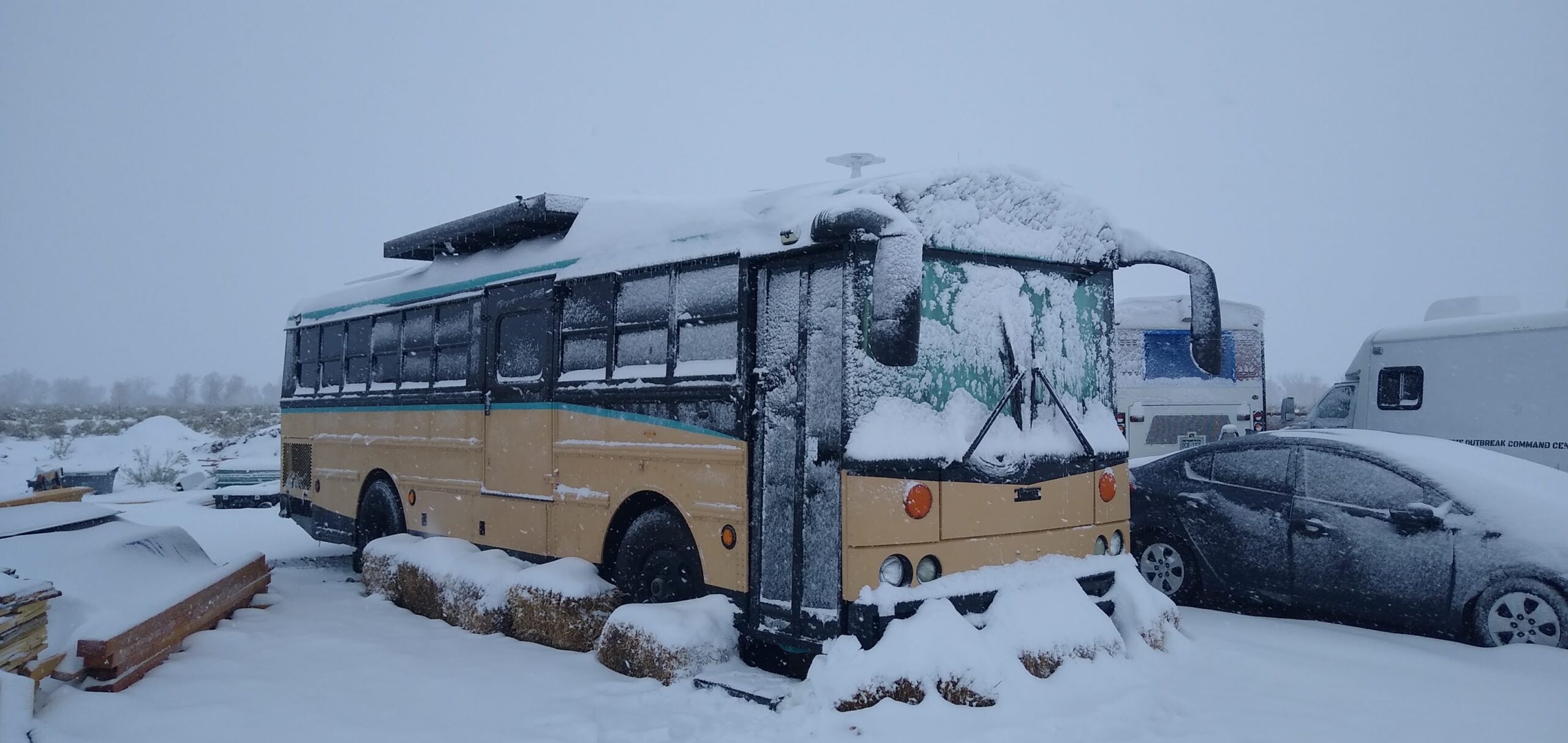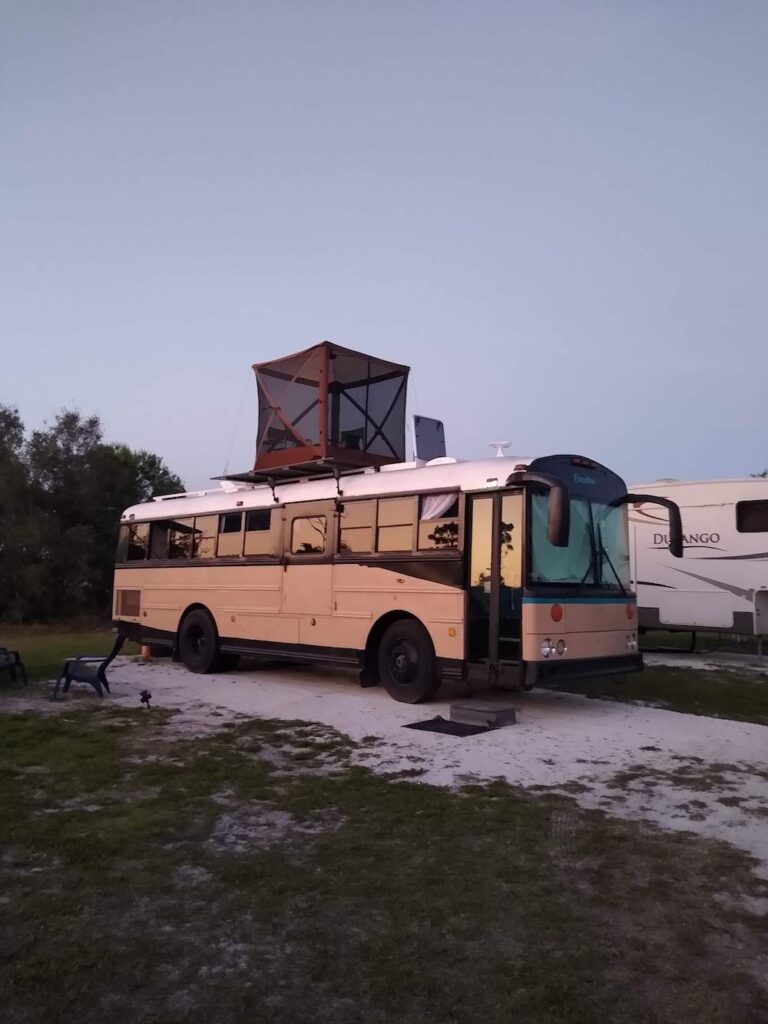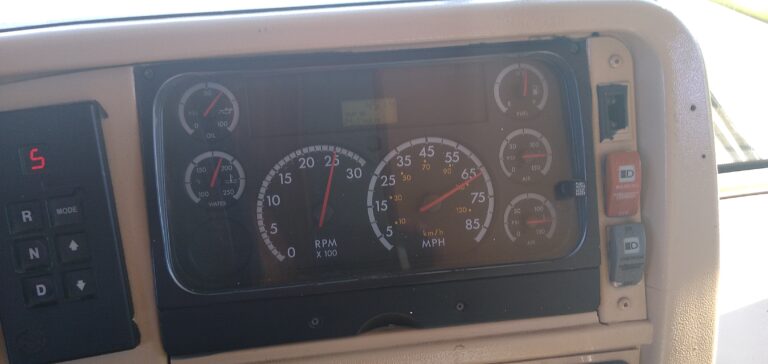How To Live In A Skoolie In The Winter
Living in a skoolie in the winter is no different than living in a skoolie in the Summer, Spring, or Fall. The only difference is the temperature.
Of course, your wardrobe, outside activities, and climate control will change somewhat, but your life as a skoolie nomad will be just as epic.
Actually, your nomadic adventures and credibility as a nomad will increase for having lived through a winter in your skoolie.
Of course, if you are spending your winters in Central or South Florida, Texas, or the desert somewhere in the Southwest, then skoolie life in the winter is no different than it is in the Spring or Summer.
As you creep further in latitude towards the North Pole. life in a skoolie begins to change. Once you reach freezing temperatures, living and traveling in a metal tube offers its own set of unique challenges.
With a little planning, preparation, and common sense, living in a skoolie in the winter should be nothing less than an amazing adventure and experience.
How Do You Live In A School Bus In The Winter?
How do you live on a school bus in the winter? One day at a time of course.
Winter living on a school bus should be no different than any other day in any other season of the year.
Of course, as we mentioned above, depending on where you are spending your winter will dictate how much you need to heat and prepare your bus for winter skoolie life.
There have been many times when we're in the South during winter, but temperatures reached down to below freezing. Were we prepared for unexpected frigid temperatures?
No, we were not. Fortunately for us though, we had our warmer clothes available to us as well as a heating source.
More thankful for anything, we had insulated our bus so well, that although it was freezing and snowing outside, we were warm and snuggled up inside of the bus.
It is a very satisfying feeling of crafting your skoolie in such a way to withstand freezing temps on the outside while keeping and maintaining warm comfortable temperatures on the inside.
It all starts with the insulation of your ceiling, walls, windows, and floor.
Should I Insulate My Skoolie?
Let us be perfectly clear on this matter of whether or not you should insulate your school bus.
YES!
Do not for a second think that the factory insulation in your school bus is sufficient enough for you to live in it unless you are genuinely going to be in 73-degree temperatures, night and day every day of the year.
Here is the truth on school bus factory insulation.
School bus manufacturers are required by law to insulate school buses because they transport children to and from school to home in all kinds of weather.
The insulation placed in these buses is minimal insulation designed for one hour or less of travel time in the bus.
The windows are single-pane windows. They are not designed to hold in warmth or cold air. They are designed to ventilate if need be.
Skoolies however, are designed to be lived in. If you were only going to be in your skoolie a couple of hours a day, then we would tend to agree that no additional insulation should be required.
That is never the case though. Even if you are only planning on living and traveling in your skoolie part-time, you need to keep it insulated so that you can effectively regulate the temperatures inside.
Even if you are an outdoor enthusiast and spend your time lounging outside of your bus, you still sleep in it.
It’s not always about cold weather. For the first six months of our first skoolie project, we did not have air conditioning and we were in Central Florida.
Central Florida in the months between December and May has average temperatures of 49 degrees low in January to 88 degrees in May.
Even though it would occasionally get down into the high 40s and low 50s, the average temp for Central Florida in January was still a humid 73 degrees.
How Do You Insulate A School Bus For Winter?
Insulating your school bus for winter is just as important as insulating your school bus for the summer climates.
What is the difference between insulating your bus for the two seasons?
No difference at all.
Your insulation for your skoolie is not based on cold or warm weather. It is based on both of them. You need to insulate your school bus for both extreme temperatures of weather.
It is equally important to keep your bus as cool as possible in the warmer months as it is to keep it warm as possible in the colder months.
This becomes especially true if you have children and pets.
Regardless of which type of insulation you chose to use, it needs to be a minimum of 2” of thickness.
We wrote a good piece on Skoolie Insulation, just about everything you need to know about insulating your school bus is there.
Ceiling, Walls & Floor
When it comes to the ceiling, walls, and floor of your school bus, we recommend sealing it first of all, then adding your preferred insulation material at a minimum of 2 inches of thickness.
Wool, Fiberglass, or Rockwool
When using a batting insulation material such as wool, fiberglass, or Rockwool, it is important not to “cram” it in there. Allow it to stay in its natural expanded form.
Without the air pockets in between the fibers, it will lose its R-value by a great deal.
Spray Foam
If you are using spray foam, the structural ribs are a good reference point for the two inches of thickness. Spray foam is our preferred method of insulation.
Not only does it seal your bus, it acts as a great sound deadening material as well. It’s R-value is the best per square inch of any of the other insulation materials.
Rigid Foam Board
A rigid foam board is great for floor insulation. It is less efficient for the walls and ceiling because of the curvature of the ceiling and different structural points of the wall.
It is an excellent insulation material, just not as pliable and easy to get into crevices and cracks as the other materials.
Windows
The windows in your skoolie are the single most area for losing heat and cool air inside of your bus.
There are ways to reduce the conduction of warm or cold air through your skoolie windows. We will touch on that in a moment.
Insulating your windows can be done very effectively if you put the time, materials, and knowledge into properly insulating them.
We use a two-step approach to insulating our windows in the winter.
We use Thinsulate as an addition to the corrugated plastic board. It is the yard signs you see on Saturday mornings for Open Houses and Yard Sales.
It is rigid and has air pockets throughout, which makes for good insulation material.
We wrap that on both sides with Thinsulate. Thinsulate is better than reflectix because it has a higher R-value.
Thinsulates’ R-value rating is 5.2 per square inch. By doubling that, you are getting a minimum of 10.4 per square inch of insulation on your windows.
Wool only has an R-value of 3.3 per square inch.
Reflectix only has an R-value of 1.1. As you can see, reflectix is not even worthy of mentioning when it comes to insulation material, even for the windows of your skoolie.
We recommend Thinsulate as its R-value is respectable and it is easy to work with. Worth mentioning is that Thinsulate also is hydrophobic and non-toxic.
Insulated Black Out Curtains
In addition to Thinsulate window inserts, we recommend insulated black-out curtains to cover your windows as well.
We like it dark inside of the bus at night for a couple of reasons.
- It makes for a cozy sleep with no outside lights creeping in and piercing our eyeballs.
- It makes for nice stealthy camping experiencing from outside sources and people.
The better insulated your windows are, the more comfortable you are going to be in both warmer as well as colder climates.
Heat, and Condensation on your Windows
While you are insulating your windows, there are ways to reduce the condensation as well. It all starts with the type of heating fuel you are using.
Propane stoves and heaters put off a lot of moisture through the burning of the gas. That moisture will gravitate to cool surfaces. The largest cool surface is likely to be your windows.
Diesel heaters and wood-burning stoves give off a dry heat. You are unlikely to have any condensation on the inside of your windows using these heating sources.
How Do You Heat A School Bus?
There are better ways than others of heating up the inside of your skoolie on a cold winters’ day. Some are great ideas, some are dangerous and some are just right.
Propane Heater
Propane heaters such as the Little Buddy series are a quick and easy way to heat up the inside of your skoolie.
They do come with a couple of liabilities in our opinion.
- Propane, just like diesel and gasoline is on the rise in prices. If you opt to use the one-pound propane bottles you purchase at Walmart or Tractor Supply, then it is even more expensive.
- Another liability in our opinion is the moisture or condensation propane introduced to the air inside of your bus. It will create condensation on anything metal, ceramic, or anything else it can attach to.
Diesel Heater
Installing a diesel heater in your skoolie is a great idea for climate control. The heat given by a diesel heater is clean and very dry. You should not experience any condensation from the diesel heater.
Buyer beware however for the cheap Chinese Diesel heaters you can purchase online or from Amazon.
While the price of around $150.00 is very attractive to the budget-minded builder, the reliability of those heaters is far less than reliable.
We recommend and are choosing for our current build the Webasto Diesel Heater. While the price seems hefty at over $1,200, the reliability and reputation of Webasto are worth the extra money in our minds.
Heat Pump
If you have or are planning on installing a mini-split air conditioner, you may want to consider getting one with a heat pump. Although the heat put out on a mini-split does not compare to a diesel heater, it does put out heat.
If you are not planning on being in colder temperatures, then the temperament cold in the south may be enough for it to handle your needs.
Electric Heat
Electric heat is a good dry heat. No condensation and will put out fast hot air to warm up your area of the skoolie you want to be the warmest.
Not the most efficient of heating sources, but certainly practical. With that being said, unless you have a generator or plan on hooking up to a shore power outlet, an electrical heater will drain your house batteries quickly.
It is not an energy-efficient source of heat. If you are in a crunch though and need heat or risk hypothermia, then it is a viable source of warmth.
Are School Buses Good In The Snow
Depending on your experience of driving in the snow and the location of where the snow is, a school bus can hold its own even in the worst snowstorm conditions.
We drove our skoolie through the Rocky Mountains a couple of years ago and were caught up in a heavy, wet, white-out, October snowstorm while crossing the Berthoud Pass into Winter Park, Colorado.
Some school buses are equipped with electronic snow chains. These chains will drop and give your drive tires traction in ice or snow.
You can always put on the traditional snow chains if you find yourself in a precarious snow situation.
Overall though, a school bus drives quite well on snow. The weight of the bus with the traction of the all-season tires is usually enough to allow it to operate safely in all weather conditions.
If it is safe enough to transport children to and from school, it should be safe enough to transport you and your family from one location to another.
How Thick Is A School Bus Floor?
The floor of your skoolie is no place to pinch pennies and time spent when converting your school bus to a tiny house on wheels.
Even when we insulated our floor with 1-inch rigid foam board, and ¾ inch plywood, the floor was still very cold while parked in the Colorado mountains with snow on the ground.
We definitely recommend using some sort of carpet on your skoolie floor, unless you sacrifice headroom for another inch of floor insulation. Two inches of insulation would be optimal, but not always practical.
A diesel heater, with its vents at ground level, does a pretty good job of helping the floor stay warm in very cold conditions as well.
Wrap Up To How To Live In A Skoolie In The Winter
We want to live in a skoolie in the winter, spring, summer, and fall! Our intent is to experience all of the seasons in all of the locations. While we are beach lovers, the snow and winter are a great place to be as well.
We just want to be comfortable, cozy, and warm when we adventure into the Great White North!
How you decide to keep your bus warm is all about you! There is no “right” way to winter skoolie living, there is only your way. We live and learn from our failures and our victories.
It is how we adapt, learn and overcome our failures that predict our future victories. Living in a skoolie in the winter is a great platform for that formula.
How cold have you traveled in your skoolie and how comfortable were you inside of your bus?








When you say eclectic heat, do you mean a plug radiating heater or a space heater with a fan?